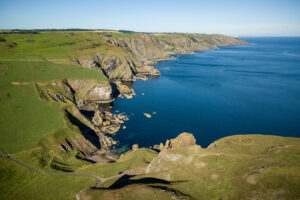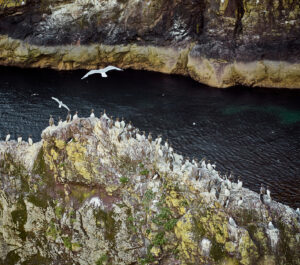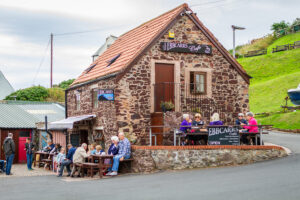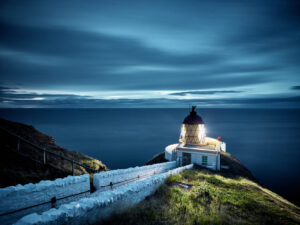MORE FROM SCOTLAND MAGAZINE
St Abbs: The smugglers’ trail
We explore St Abbs, which forms part of Berwickshire’s smugglers’ trail, and is the kind of unassuming village that you’ll want to hide away in…
Words: Sally Coffey
St Abbs: a history of the smugglers’ trail
With its craggy coastline, steep cliffs, and generous scattering of sea stacks, the Berwickshire coastline in Scotland’s southeast has historically provided perfect cover for illicit goings on.
You can still just about make out the steps carved into land that ascended from the shore right up to the headland in some places, where smugglers would haul their cargo up and out of the line of sight of customs of officers under the cloak of darkness.

can still make out the steps that smugglers used to climb up from the
shore along the Smugglers’ Way
Contraband in these parts in the 18th century was most often tea, but also sometimes brandy and tobacco, and one of the most notorious smugglers in the area was John Nisbet, owner of Gunsgreen House in the fishing village of Eyemouth. Today a heritage centre/self-catering property, Gunsgreen House is rather creaky round the edges but shows good promise, with secret passages used by Nisbet and his contacts, and even a hidden tea chute. All it needs is a little investment, something that the charity that runs it is working hard to secure, and it will be a great attraction along this underrated coastline.
Things to do in St Abbs
From Eyemouth it’s a very picturesque walk north along the coastal path to St Abbs, a pretty village hemmed in by rugged cliffs, with old fishermen cottages that look as though they are being beckoned down to the sea.
Younger visitors tend to recognise St Abbs for its role as New Asgard in Avengers: Endgame. It’s an association made a bit of a fuss about in the fantastic visitor centre that stands proud high up above the harbour, though not all locals are keen to be reminded of the link.
The visitor centre also explores other parts of St Abbs’ story, from its fabled origins as a village that grew up around a nearby 7th-century nunnery founded by a shipwrecked Norwegian princess named Æbbe, who gave the village its name, to its abundance of wildlife.
The promontory where that first nunnery is believed to have stood is just to the north of the village and is part of what is known today as St Abb’s Head.

Today this headland is brimming with birdlife, butterflies, and lots of native flora and fauna. It’s hard to believe that nature ever takes a break here, but from spring to early summer – breeding season for many – its cliffsides and stacks are particularly packed with loud, busy birds.
Find a safe spot on the headland and sit down and you’ll see (and hear), thousands and thousands of seabirds, from guillemots to razor bills, kittiwakes, and shags – even a thriving relatively new population of gannets.
The nearby National Trust nature centre is a good source of information on the birds you see and the rangers are passionate and knowledgeable, or you can book a private tour with In Our Nature, run by an ex ranger Liza Cole, who can explain everything, from the behaviour of the birds and how to recognise them, to where to see some of the coastline’s bountiful seal population.
But while most people venturing to this part of Scotland come for the wildlife or to enjoy the great outdoors, for those living here, before tourism became a viable alternative, there were two main industries: sheep farming and fishing.
It’s good to see that both these industries continue today, and St Abbs itself, far from being a twee picture-postcard village, is still home to a busy fishing community. You can buy lobster and crab straight from the boat, or pop into the ever-popular and very friendly Ebbcarrs Cafe, right by the harbour, where you can tuck into a fresh-as-it-comes homemade crab sandwich.

For the life of me I haven’t been able to work out why locals refer to them as poo sandwiches – perhaps it’s to make them sound so unappetising that us outsiders will leave them alone (if this is the reason, it’s not working).
There is also a growing artisan food scene in Berwickshire, and if your legs will carry you up the steep hill that leads from the harbour past the visitor centre, you can try some of it in the Old School Cafe. If you have any sense, you’ll order one of the Jarvis Pickle pies.
If you’re looking for somewhere to stay in St Abbs, then you can’t go wrong with the well-placed Seaview B&B, which offers cosy rooms and good company, plus both a sunroom and a sun-trap garden for taking in those sea views its name boasts of.
From St Abbs it is a beautiful walk along the coast path to Eyemouth. The highlight of which is Coldingham Bay, a wide arc of golden sands with beach huts that are so popular I’ve heard of people who have been on the waiting list for 30 years, and a cool beach café.

It will take you a couple of hours to walk to Eyemouth, but it’s a great way to soak up the maritime atmosphere and look down upon hard-to-reach little coves and wonder at the nefarious activities that would once have taken place there.
If you don’t fancy walking back, you can either book onto one of Tim Grimshaw’s shuttle services through Eyemouth RIB Rides, or book into Nisbet’s Tower, named after that most notorious of local smugglers.
Nisbet’s Tower is a cute, castellated, converted 18th-century doo’cot, which looks out over Nisbet’s former home and would have been a great spot for any customs officers to peer down from. If only they knew.
St Abbs: Plan your visit
St Abbs is about an hour’s drive from Edinburgh, or if you would rather take the train, then you can alight at Berwick on Tweed, from where it’s a short taxi ride with Kiwi Cabs. There are regular trains from Edinburgh with ScotRail, and London with LNER.
Once here, your two feet will do you in good stead for much of it, and the new Pingo app, which allows you to order a bus on demand, is a genius idea. For more information on visiting the area, go to visitberwickshirecoast.co.uk
Read more:

SCOTLAND MAGAZINE
Published six times a year, every issue of Scotland showcases its stunning landscapes and natural beauty, and delves deep into Scottish history. From mysterious clans and famous Scots (both past and present), to the hidden histories of the country’s greatest castles and houses, Scotland‘s pages brim with the soul and secrets of the country.
Scotland magazine captures the spirit of this wild and wonderful nation, explores its history and heritage and recommends great places to visit, so you feel at home here, wherever you are in the world.












